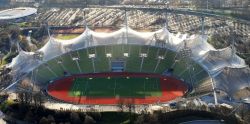Olympiastadion (German pronunciation: [ʔoˈlʏmpi̯aːˌʃtaːdi̯ɔn]) is a stadium located in Munich, Germany. Situated at the heart of the Olympiapark Munchen in northern Munich, the stadium was built as the main venue for the 1972 Summer Olympics.
With an original capacity of 80,000, the stadium also hosted many major football matches including the 1974 FIFA World Cup Final and the UEFA Euro 1988 Final. It hosted the European Cup Finals in 1979, 1993 and 1997. Its current capacity is 69,250.
Until the construction of Allianz Arena for the 2006 FIFA World Cup, the stadium was home to FC Bayern Munich and TSV 1860 Munich. Unlike the Olympiastadion, the new stadium was purpose-built for football alone.
History
Shortly after World War I, there were first considerations to build a large stadium in Munich, as football gained popularity. A stadium construction on Oberwiesenfeld failed in 1919 due to an objection by the Bavarian state. 1921 the Teutoniaplatz was opened by the club FC Teutonia with a capacity of 12,000. In the month after the opening about 20,000 guests came to a game, which was almost twice the officially allowed capacity. The FC Bayern used the Teutoniaplatz for his home games from 1923 to 1925. Starting in 1911, the TSV 1860 played on the club's own field at the Grunwalder Strase in Giesing, which became the largest stadium in Munich after it was expanded to a capacity of 40,000 spectators in 1926.
Although the capacity was sufficient for championship operation, the Teutoniaplatz was filled to its limits in international matches: the game Germany against Switzerland in 1926 showed that the demand for tickets in major events was a much higher than the allowed capacity. The 1928 opened fight course on the Dantestrase did not meet the expectations of a large stadium. For this reason, the construction of a large stadium on the outskirts of Munich, for example on Oberwiesenfeld, was discussed during the Weimar Republic, but did not yield any particular results.
In the ea
